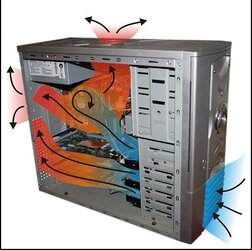Traditionally the motherboard components needed as much cooling as the cpu. No longer. With that HAF case you can set up a wind tunnel.
Top forward fan position: TY-140. It is a 140mm PWM fan with 120mm screw holes. Block off all other fan positions on top. Get
this, or
this, or
this, and put your PWM fans on it. Plug the power input in a Molex, and the PWM plug into the CPU fan header. That way your fans will speed up when your cpu is loaded, and slow down on idle.
Put your DVD in the bottom 5.25 slot. Use the upper 3 slots for a 120mm or 140mm fan. If the top of the bay is not closed, you can fit a 140mm fan in there. If you bought a PWM splitter with enough branches you can make your front intake into a fan that speeds up when the cpu is loaded . . .
Remove your rear fan. Cut out your rear grill, preferably with a
nibbler. Having an empty square in the rear will allow your air to flow silently out the back. No fan needed.
Remove all unused backplane slot covers. That will allow your gpu to breathe.
Remember: air goes where you push it. Left alone, hot air rises, but even the weakest fan can counteract that. If you let your motherboard warm the air that goes into your heatsink you compromise its ability to cool your cpu.
